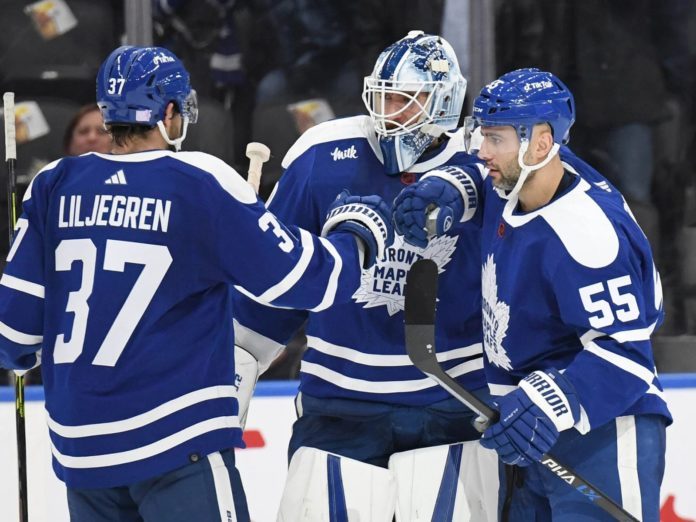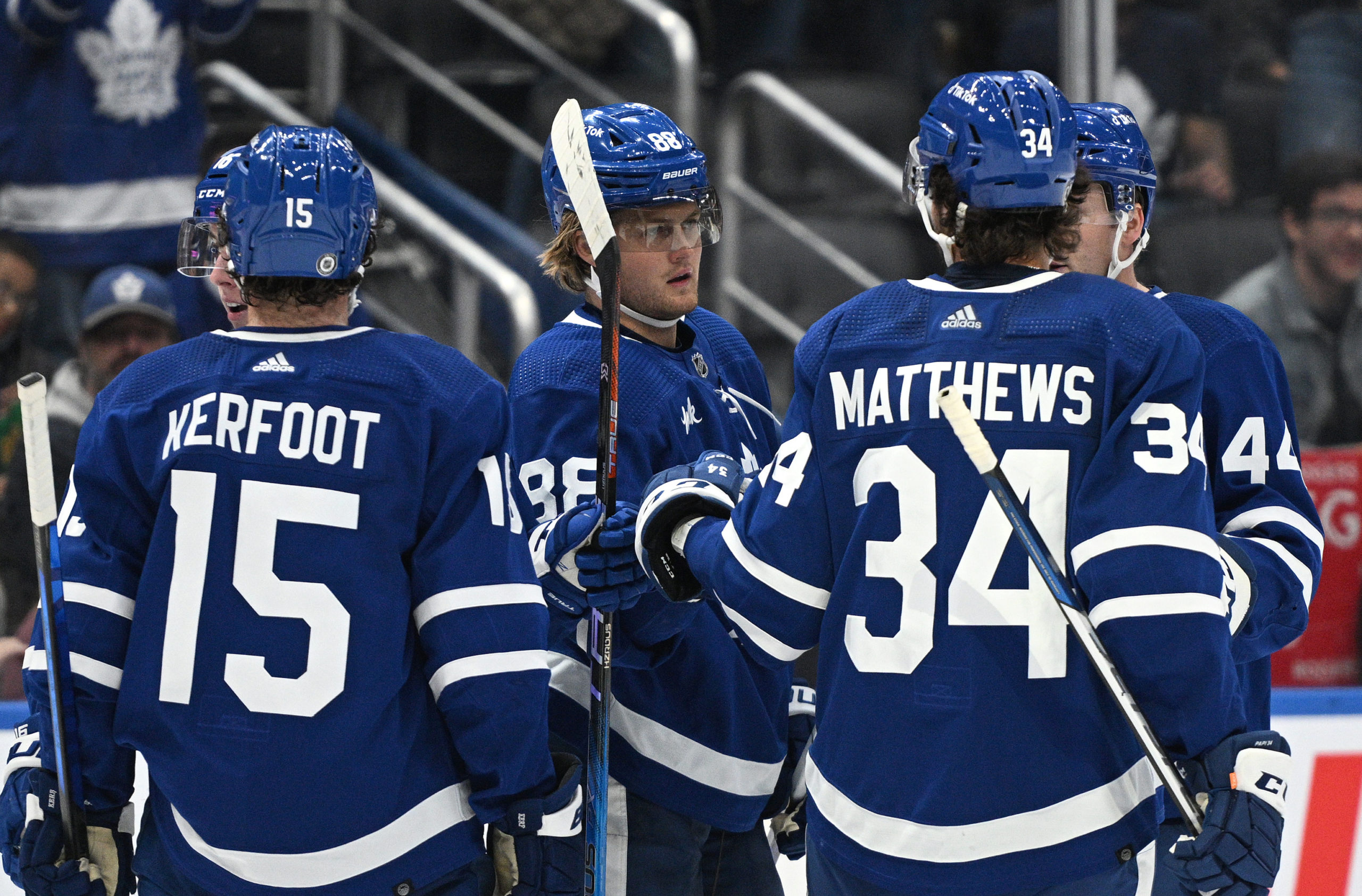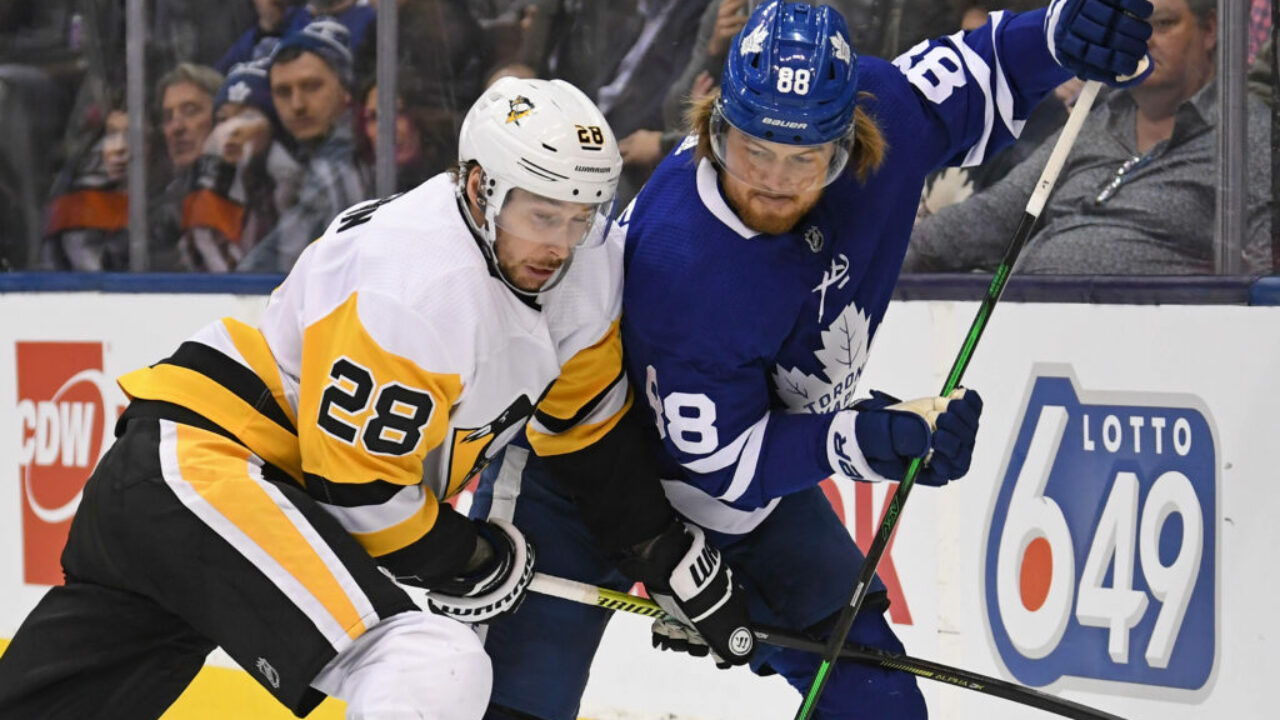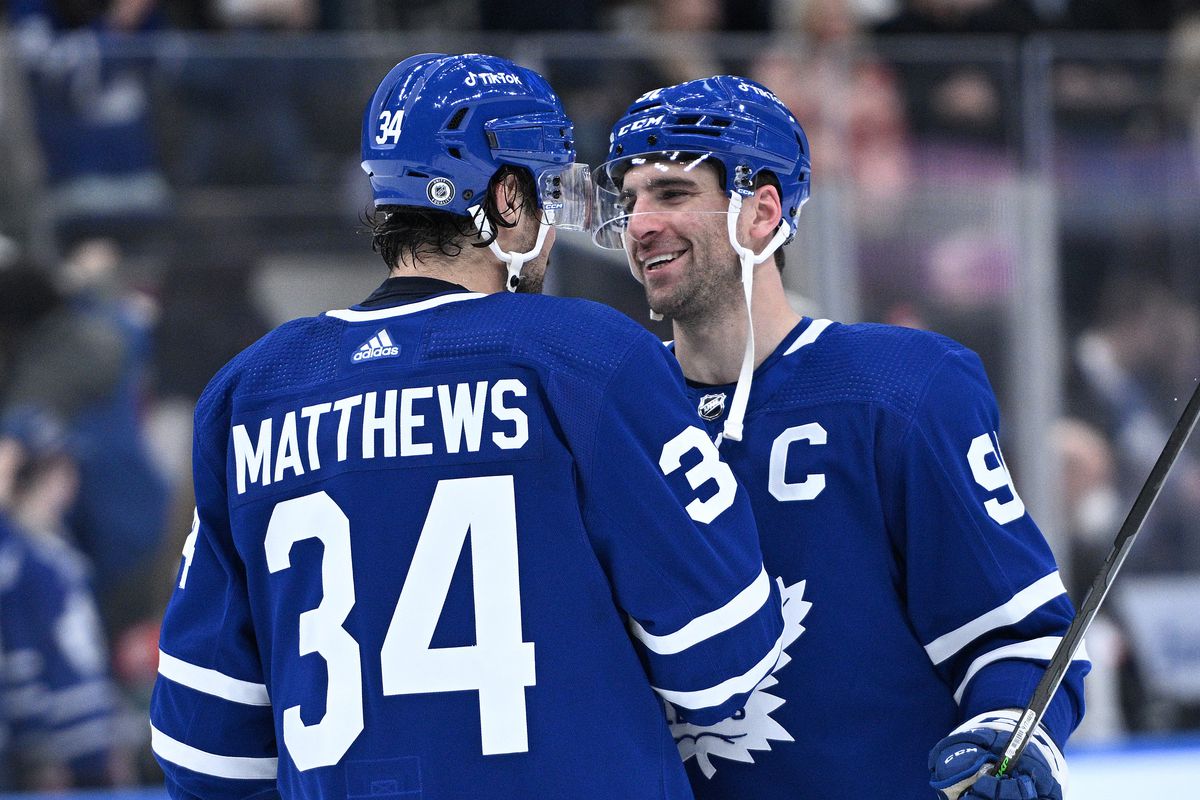
The Maple Leafs have a busy week ahead with four games in six days.
A perfect time for an extended notes edition of Leafs Notebook.
Notes

– It was nice to see the Leafs hand it to Buffalo after last year’s season series. The last two games against them were a loss in the Heritage Classic followed by a 5-2 loss. Those are the kinds of losses that fans don’t forget, and these are the kinds of rematch games that fans circle on the calendar.
To see the Leafs hand them their eighth straight loss quite handily is all kinds of enjoyable. Similarly, last week, the Leafs got redemption against the Penguins after flaming out at home in the Hall of Fame game. It’s subtle – and I’m not sure if the current players even care about losses to Buffalo last season (my bet is at least some didn’t forget) – but it’s nice to see the Leafs even some scores.
– So far this season, according to Natural Stat Trick, the Leafs are generating roughly three fewer scoring chances per game at 5v5 while also giving up three fewer scoring chances against at 5v5 per game. There has been a definite focus on lower-event hockey and locking games down.
Against Buffalo, there were some good examples of the Leafs turning good defense into transition offense. Below is a clip of Auston Matthews hanging back through the neutral zone and creating a turnover that he instantly turned up ice into a scoring chance. When Tage Thompson originally picked up the puck, Matthews could have pursued and inched up ice, either trying to create a turnover himself or cheating up the ice hoping that Michael Bunting was able to create it. Instead, he retreated back defensively, created the turnover himself, and quickly transitioned up the ice.
Later in the game, William Nylander scored a goal off a turnover – this time it was John Tavares tracking back hard and – with the help of Justin Holl – creating a turnover before flipping the puck up ice leading to a breakaway goal.
– Over the years, we’ve seen a lot of teams undertake this evolution from a high-octane offensive team to a club that defends more, creates turnovers, and shoves mistakes down the opposition’s throat.
In the early years with this core, we saw the Bruins do this to the Leafs quite a bit, and Tampa buckled down in the playoffs – in Game 7, in particular – to do it as well. So far this season, the Leafs appear to be focusing a little more on defending and aren’t trading scoring chances as much. We’ve definitely seen some Octobers and Novembers from the Leafs where it has been a track meet. How many games match that description so far this season?
– Last season, the Leafs recorded some spectacular underlying numbers on the penalty kill. They gave up the third-fewest shot attempts and the third-lowest expected goals against. They were fourth in high-danger scoring chances against.
This season, it has regressed a little: seventh in expected goals, 15th in shot attempts, and 15th in scoring chances against. They are also 10th in shorthanded time on ice so far this season compared to 15th last season.
One thing they have lost on their PK units is speed, and they aren’t nearly as aggressive as a result. Last season, Ilya Mikheyev and Ondrej Kase were burners. Calle Järnkrok isn’t nearly as fast. Sometimes, the Leafs are lulled into trying to clog up lanes instead of pressuring puck carriers.
On this Sabres power play goal, both Alex Kerfoot and Järnkrok are way back of Owen Power and both are attempting to clog the shooting lane. Nobody is pressuring him, which means he has time to either wind up or in this case, set up Victor Olofsson for a one-timer that leads to an easy goal.

Look at how much time and space the Sabres have there.
– Kind of quietly, Morgan Rielly has seven points in his last six games. It’s quiet because none of them have been goals. He has yet to score this season, but he has 16 points in 19 games, which puts him on pace for 69 points (three off his career-high 72-point season back in 2018-19).
However, not scoring isn’t just bad luck. Rielly is averaging 1.68 shots on net per game, which would be his lowest per-game rate since his rookie season. He is simply passing up shots at this rate, and while it’s likely the smart play when he’s quarterbacking the power play, he does need to shoot some to keep teams honest and also to generate some offense.
– During Morgan Rielly’s 73-point season, he was paired with Ron Hainsey, and while I don’t think Jordie Benn should play with him all season, I see some similarities between the two in the sense that they’re two veteran defensive partners that hang back and encourage Rielly to jump up offensively.
– As a general reminder: it makes no sense to look at point totals when discussing the standings. Obviously, teams have played different numbers of games, so we’re not judging them equally. It’s about points percentage. By that measure, the Leafs sit 10th as opposed to tied for fourth in total points, which is much more indicative of their overall play so far this season.
Quotes

“It may come off as strange, but in my role with the team, I personally think going through these types of things — whether it is injury or poor play that results in some consternation about where we are at — is a very positive thing. You learn a lot about the people you are with day in and day out. You learn who can handle it and who may not be able to.”
– Kyle Dubas on the team’s early season ups and downs.
The other nice thing about a little adversity early in the season is that it usually forces changes such as swapping Mitch Marner and William Nylander. Last season, Auston Matthews scored 60 goals and Marner racked up 35 goals and 97 points in just 72 games. How could one justify splitting it up as the team rattled off a franchise-record 115-point season?
It’s a tough case to make to the players to break it up. The stars and the team at large were feasting. While the team is in a fine place in the standings now, a few weeks ago, we couldn’t exactly say the same, and that’s what drives changes to the lineup.
The early adversity has resulted in a number of positive lineup changes for the Leafs to this point. I’m not sure we would have seen it if they didn’t start a little slowly.
“When he gets playing down below the dots in the offensive zone, if you are the opposition in the offensive zone, he is a hard guy to get through and to move around. He gets in the way. When he gets the puck, he does a really good job of skating it out of the zone and making a play on it.
“Those are the elements that he brings there. You lose some of what he brings on the wing where he can really get ahead of the play and really push the pace offensively when he gets ahead of it and is F1 on the forecheck. He can get on top of the puck first.”
– Sheldon Keefe on Pierre Engvall’s strengths on the wing
“It’s a combination of that and keeping some of the other lines looking similar, and bringing Holmberg in gives us a natural center in that line as well.”
– Sheldon Keefe on Pontus Holmberg as a natural center, creating the domino effect of keeping other players in their natural spots
I think this approach makes sense. I have said it a million times, but Pierre Engvall is better on the wing, specifically on the left side. Calle Järnkrok, throughout his career, has been at his best on the right side. I am not sure if Pontus Holmberg is the 3C answer for this season, but playing the other two established NHLers at their best positions is a logical approach to at least trying to maximize the line.
“He made a heck of a play in the first on that PK … we ended up scoring Gio’s goal. That was a big moment for us. He’s as solid as they come. He’s definitely an unsung hero here, so I wanted to show him some love.”
– Matt Murray on David Kampf after giving him the post-win belt
It is really difficult to find good NHL centers, and David Kampf is a legitimately good NHL center. He is just a steady, honest player who stops on pucks, uses his body to win puck battles, and chips in offensively.
Kampf rather quietly has eight points in 19 games so far this season. Against New Jersey, on a shift where the Devils were applying pressure, he went into a battle for the puck by dropping his shoulder, allowing him to establish inside position, control the puck, and get it out of the zone. He’s just a fundamentally sound player.
Tweets of the Week

We were just discussing Matthews on the show…looks off so far this year…feels like his scoring has been down. 7 goals in 17 games. You know how many goals he had through 17 games last year? 7. That shocked me.
— Sam McKee (@SamAMcKee) November 16, 2022
I was also surprised to hear that Auston Matthews scored seven goals in his first 17 games played last season, too. He then racked up 53 goals in his next 63 games. That’s how elite he is at scoring and hot he can get in the blink of an eye.
So far this season, there have been a lot of times when Matthews hasn’t exactly looked right, and yet there he is with 20 points in 19 games – starting at the same goal pace as last season, no less. The expectations are just so high because he’s so, so good.
Alex Kerfoot has one goal in 18 games, and it was a power-play goal.
His 5v5 shooting percentage won't be 0 forever, but he didn't have a shot on goal last night while playing with 16 and 91.
Given his $3.5M cap hit, the Leafs need more out of him offensively.
— Kevin Papetti (@KPapetti) November 18, 2022
On the heels of a career-high 53-point season, Alex Kerfoot is currently playing at a 26-point pace. Some of it will normalize, and he’ll likely go on a point streak of some sort by virtue of being shoehorned into the top six. His speed genuinely does cause problems for opponents, and he is good on the penalty kill. He can even make some heads-up plays with the puck, but he’s scored at a 14-goal pace throughout his career.
Last week, with a prime chance in the slot against the Penguins after a defender fell down, Kerfoot passed it off to a covered John Tavares. To play on either of the top two lines, you have to represent some sort of scoring threat. Kerfoot simply hasn’t shown that in his career, and he’s definitely not showing it this season.
Excluding empty-netters, the Leafs have scored more than 3 total goals in 2 games this year.
At 5v5 they've scored 2 or fewer in 14 of 18 games and have given up 2 or fewer goals in 15 of 18.
Maybe I'm fucking stupid but I'd rather buy more scoring with my available cap room.
— Active Stick (@TheOakLeafs) November 18, 2022
Further to the note above, the team is averaging three goals per game, which is 20th in the league. The Habs(!) are 19th. I still think the Leafs are due to improve naturally over time, but even when they do, I think they need another scorer, which we discussed throughout the summer. If the top four are kept in check, it’s hard to see them winning the game right now.
Five Things I Think I’d Do

1. Building off of the point about the lack of scoring from Alex Kerfoot, I think I’d at least try to put Pierre Engvall in the top six for a few shifts over him. Engvall doesn’t really deserve it due to his overall play this season, but he can definitely shoot, and he’s stronger than Kerfoot. They are equally fast.
Michael Bunting has generally earned his spot up the lineup, and while he has been up and down this season, I think he’s clearly ahead here. I don’t think that’s the case with Kerfoot, but we never really see them swapped for each other.
2. I think it’s fairly obvious that if you aren’t going to play Nick Robertson – and Sheldon Keefe has said that someone will have to play themselves out of the lineup in order for Robertson to get back in – they should simply send him down. He needs game time and puck touches. It is forgotten all the time, but Robertson is still only 21 years old. It’s not helping his development by having him around NHLers and getting in extra practice time. He needs to play games.
I’d rather just keep Wayne Simmonds up at that point as a veteran more suited for a limited spot-duty role.
3. I think I’m very curious as to how the Leafs run their goalies in the upcoming back-to-back when they play the Minnesota Wild on Friday followed by the Pittsburgh Penguins (yet again!) on Saturday. I would be inclined to start Matt Murray in the second game pretty well no matter what. If they start him on Friday, it will be three games in five nights (we could also look at it as four in seven, if we include Saturday). Murray is still returning from injury, and while he looks good and is hopefully finding a groove, I wouldn’t exactly throw him all the way back in there and ask him to be a horse given his history.
4. I think it’s important to talk about the team’s needs throughout the season to track how they evolve and not just look at it through the prism of a month before the trade deadline. Last week, I mentioned the need to upgrade at forward – which is something I stand by – and this week I wanted to be more specific. There is a lot of talk about adding a top-six forward, and there is a lot of merit to that. They do need a bit more scoring oomph there. But even if they were to add it, the third line is still a problem.
No, acquiring a top-six winger and moving Alex Kerfoot to play 3C does not solve the issue. On the other hand, if they acquire a third-line center, it would hopefully elevate the line and relieve a little pressure on the top two lines. They could get by asking two stars to play alongside a weaker fit, but I don’t think they can survive in the long run through the playoffs without three legitimate lines. They simply don’t have a third right now.
5. Further, I think the best the Leafs have looked over the past couple of seasons was when Zach Hyman was moved down to the third line and drove a unit with a still-recovering Ilya Mikheyev and Pierre Engvall (I think keeping him there was part of the reason they acquired Nick Foligno, who came in and slotted in on the top line until throwing his back). Last season, Mikheyev emerged as a scoring threat and led the third line. I think management is aware of this, and Keefe has made subtle references to wanting a third-line center. It makes sense.














![John Gruden after the Leafs prospects’ 4-1 win over Montreal: “[Vyacheslav Peksa] looked really comfortable in the net… We wouldn’t have won without him” John Gruden, head coach of the Toronto Marlies](https://mapleleafshotstove.com/wp-content/uploads/2025/09/gruden-post-game-sep-14-218x150.jpg)

















